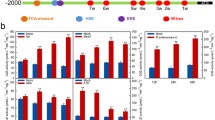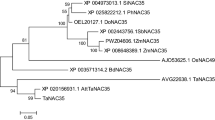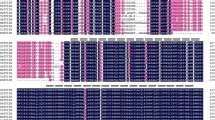Abstract
We aim to isolate genes in chili pepper that are regulated during the hypersensitive response to infection by nonhost pathogens, with a view to elucidating the defense responses against pathogen attack. Among the 90 transcription factors initially characterized by reverse RNA gel blot analysis, a cDNA clone, CaNAC1 (Capsicum annuum NAC1) containing the plant-specific NAC domain motif was further characterized. Expression of the CaNAC1 gene was rapidly and specifically induced during incompatible interactions between pepper and bacterial or viral pathogens. Additionally, this gene was strongly induced by exogenously applied salicylic acid and ethephon, whereas methyl jasmonate only had a transient effect. A CaNAC1-smGFP (soluble modified green fluorescent protein) fusion protein localized to the nucleus following transfection into the epidermis of onion. Using the yeast system, we further disclose that the transcription activation domain of CaNAC1 is located in the C-terminal half of the protein. Our results collectively suggest that the plant-specific NAC domain protein, CaNAC1, may play a role in the regulation of defense responses in plants.








Similar content being viewed by others
Abbreviations
- CaNAC1 :
-
Capsicum annuum NAC1
- SA:
-
Salicylic acid
- JA:
-
Jasmonic acid
- Xag :
-
Xanthomonas axonopodis pv. glycines
- Xcv :
-
X. campestris pv. vesicatoria
- Pss 61:
-
Pseudomonas syringae pv. syringae 61
- PMMV:
-
Pepper mild mottle virus
- PVP:
-
Polvinlypyrrolidone
References
Aida M, Ishida T, Fukaki H, Fujisawa H, Tasaka M (1997) Genes involved in organ separation in Arabidopsis: an analysis of the cup-shaped cotyledon mutant. Plant Cell 9:841–857
Alfano J, Collmer A (1996) Bacterial pathogen in plants: life up against the wall. Plant Cell 8:1683–1698
Berzal-Herranz A, de la Cruz A, Tenllado F, Díaz-Ruíz JR, López L, Sanz AI, Vaquero C, Serra MT, García-Luque I (1995) The Capsicum L3 gene-mediated resistance against the tobamoviruses is elicited by the coat protein. Virology 209:498–505
Boukema IW (1982) Resistance to TMV in Capsicum chacoense Hunz. Is governed by an allele of the L-locus. Capsicum Newsl 3:47–48
Chen C, Chen Z (2002) Potentiation of developmentally regulated plant defense by AtWRKY18, a pathogen-induced Arabidopsis transcription factor. Plant Physiol 129:706–716
Choi D, Kim HM, Yun HK, Park JA, Kim WT, Bok SH (1996) Molecular cloning of a metallothionein-like gene from Nicotiana glutinosa L and its induction by wounding and tobacco mosaic virus infection. Plant Physiol 112:353–359
Church GM, Gilbert W (1984) Genomic sequencing. Proc Natl Acad Sci USA 81:1991–1995
Collinge M, Boller T (2001) Differential induction of two potato genes, Stprx2 and StNAC, in response to infection by Phytophthora infestans and to wounding. Plant Mol Biol 46:521–529
Dangl JL, Dietrich RA, Richberg MH (1996) Death don’t have no mercy: Cell death programs in plant-microbe interactions. Plant Cell 8:1793–1807
David SJ, Vierstra RD (1996) Soluble derivatives of green fluorescent protein (GFP) for use in Arabidopsis thaliana. Weeds World 3:43–48
Duval M, Hsieh T-F, Kim SY, Thomas TL (2002) Molecular characterization of AtNAM: a member of the Arabidopsis NAC domain superfamily. Plant Mol Biol 50:237–248
Fujita M, Fujita Y, Maruyama K, Seki M, Hiratsu K, Ohme-Takagi M, Tran L-SP, Yamaguchi-Shinozaki K, Shinozaki K (2004) A dehydration-induced NAC protein, RD26, is involved in a novel ABA-dependent stress-signaling pathway. Plant J 39:863–876
Glazebrook J (2001) Genes controlling expression of defense responses in Arabidopsis-2001 status. Curr Opin Plant Biol 4:301–308
Goodman RN, Novacky AJ (1994) The hypersensitive reaction in plants to pathogens: a resistance phenomenon American Phytopathological Society. APS press, St Paul
Gu YQ, Wildermuth MC, Chakravarthy S, Loh YT, Yang C, He X, Han Y, Martin GB (2002) Tomato transcription factors Pti4,Pti5, and Pti6 activate defense responses when expressed in Arabidopsis. Plant Cell 14:817–831
He P, Warren RF, Zhao T, Shan L, Zhu L, Tang X, Zhou JM (2001) Overexpression of Pti5 in tomato potentiates pathogen-induced defense gene expression and enhances disease resistance to Psuedomonas syringae pv tomato. Mol Plant Microbe Interact 14:1453–1457
Heath MC (2000) Non-host resistance and nonspecific plant defenses. Curr Opin Plant Biol 3:315–319
Hegedus D, Yu M, Baldwin D, Gruber M, Sharpe A, Parkin I, Whitwill S, Lydiate D (2003) Molecular characterization of Brassica napus NAC domain transcriptional activators induced in response to biotic and abiotic stress. Plant Mol Biol 53:383–397
van der Hoeven R, Ronnig C, Giovannoni J, Martin G, Tanksley S (2002) Deductions about the number, organization, and evolution of genes in the tomato genome based on analysis of a large expressed sequence tag collection and selective genomic sequencing. Plant Cell 14:1441–1456
Huang HC, Schuurink R, Denny TP, Atkinson MM, Baker CJ, Yucel I, Hutcheson SW, Collmer A (1988) Molecular cloning of a Pseudomonas syringae pv. syringae gene cluster that enables Pseudomonas fluorescens to elicit the hypersensitive response in tobacco. J Bacteriol 170:4748–4756
Hwang I, Lim SM, Shaw PD (1992) Cloning and characterization of pathogenicity genes from Xanthomonas campestris pv glycines. J Bacteriol 174:1923–1931
John I, Hackett R, Cooper W, Drake R, Farrell A, Grierson D (1997) Cloning and characterization of tomato leaf senescence-related cDNAs. Plant Mol Biol 33:641–651
Kikuchi K, Ueguchi-Tanaka M., Yoshida KT, Nagato Y, Matsusoka M, Hirano H-Y (2000) Molecular analysis of the NAC gene family in rice. Mol Gen Genet 262:1047–1051
Kranz HD, Denekamp M, Greco R, Jin H, Leyva A, Meissner RC, Petroni K, Urzainqui A, Bevan M, Martin C, Smeekens S, Tonelli C, Paz-Ares J, Weisshaar B (1998) Towards functional characterization of the members of the R2R3- MYB gene family from Arabidopsis thaliana. Plant J 16:263–276
Lee SJ, Lee MY, Yi SY, Oh S-K, Choi SH, Her NH, Choi D, Min BW, Yang SG, Harn CH (2002) PPI1: a novel pathogen-induced basic region-leucin zipper (bZIP) transcription factor from pepper. Mol Plant Microbe Interact 15:540–548
Lee S, Kim SY, Chung E, Joung YH, Pai H-S, Hur CG, Choi D (2004) EST and microarray analyses of pathogen responsive genes in hot pepper (Capsicum annuum L.) Non-host resistance against soybean pustule pathogen (Xanthomonas axonopodis pv glycines). Funct Integrat Genomics 4:196–205
Li J, Brader G, Palva ET (2004) The WRKY70 transcription factor: a node of convergence for jasmonate-mediated and salicylate-mediated signals in plant defense. Plant Cell 16:319–331
Murashige T, Skoog F (1962) A revised medium for rapid growth and bioassays with tobacco tissue culture. Physiol Plant 15:473–497
Mysore KS, Crasta OR, Tuori RP, Folkerts O, Swirsky PB, Martin GB (2002) Comprehensive transcript profiling of Pto- and Prf-mediated host defense responses to infection by Pseudomonas syringae pv tomato. Plant J 32:299–315
Ooka H, Satoh K, Doi K, Nagata T, Otomo Y, Murakami K, Osato N, Kawai J, Carninci P, Hayashizaki Y, Suzuki K, Kojima K, Takahara Y, Yamamoto K, Kikuchi S (2003) Comprehensive analysis of NAC family genes in Oryza sativa and Arabidopsis thaliana. DNA Res 10:239–247
Park JM, Park CJ, Lee SB, Ham BK, Shin R, Paek KH (2001) Overexpression of the tobacco Tsi1 gene encoding an EREBP/AP2-type transcription factor enhances resistance against pathogen attack and osmotic stress in tobacco. Plant Cell 13:1035–1046
Pontier D, Miao ZH, Lam E (2001) Trans-dominant suppression of plant TGA factors reveals their negative and positive roles in plant defense responses. Plant J 27:529–538
Ren T, Qu F, Morris TJ (2000) HRT gene function requires interaction between a NAC protein and viral capsid protein to confer resistance to turnip crinkle virus. Plant Cell 12:1917–1925
Reymond P, Farmer EE (1998) Jasmonate and salicylate as global signals for defense gene expression. Curr Opin Plant Biol 1:404–411
Riechmann JL, Heard J, Martin G, Reuber L, Jiang C-Z, Keddie J, Adam L, Pineda O, Ratcliffe OJ, Samaha RR, Creelman R, Pilgrim M, Broun P, Zhang JZ, Ghandehari D, Sherman BK, Yu G-L (2000) Arabidopsis transcription factors: genome-wide comparative analysis among eukaryotes. Science 290:2105–2110
Robatzek S, Somssich IE (2002) Targets of AtWRKY6 regulation during plant senescence and pathogen defense. Genes Dev 16:1139–1149
Ruiz-Medrano R, Xoconostle-Cázares B, Lucas WJ (1999) Phloem long-distance transport of CmNACP mRNA: implications for supracellular regulation in plants. Development 126:4405–4419
Ryals JA, Jeuenschwander UH, Willits MG, Molina A, Steiner H-Y, Hunt MD (1996) Systemic acquired resistance. Plant Cell 8:1809–1819
Sablowski RWM, Meyerowitz EM (1998) A homolog of No APICAL MERISTEM is an immediate target of the floral homeotic genes APETALA3/PISTILATA. Cell 92:93–103
Souer E, van Houwelingen A, Kloos D, Mol J, Koes R (1996) The No Apical Meristem gene of petunia is required for pattern formation in embryos and flowers and is expressed at meristem and primordial boundaries. Cell 85:159–170
Spoel SH, Koornneef A, Claessens SMC, Korzelius JP, Van Pelt MJ, Mueller AJ, Buchala JP, Metraux A, Brown R, Kazan K, Van Loon LC, Dong X, Pieterse CMJ (2003) NPR1 modulates cross-talk between salicylate- and jasmonate-dependent defense pathways through a novel function in the cytosol. Plant Cell 15:760–770
Suh MC, Oh, S-K, Kim Y-C, Pai H-S, Choi D (2003) Expression of a novel tobacco gene, NgCDM1, is preferentially associated with pathogen-induced cell death. Physiol Mol Plant Pathol 62:227–235
Tai TH, Dahlbeck D, Clark ET, Gajiwala P, Pasion R, Whalen MC, Stall RE, Staskawicz BJ (1999) Expression of the Bs2 pepper gene confers resistance to bacterial spot disease in tomato. Proc Natl Acad Sci USA 96:14153–14158
Takeuchi Y, Dotson M, Keen NT (1992) Plant transformation: a simple particle bombardment device based on flowing helium. Plant Mol Biol 18:835–839
Vailleau F, Daniel X, Tronchet M, Montillet JL, Triantaphylides C, Roby D (2002) A R2R3-MYB gene, AtMYB30, acts as a positive regulator of the hypersensitive cell death program in plants in response to pathogen attack. Proc Natl Acad Sci USA 99:10179–10184
Xie Q, Sanz-Burgos AP, Guo H, García JA, Gutiérrez C (1999) GRAB proteins, novel members of the NAC domain family, isolated by their interaction with a geminivirus protein. Plant Mol Biol 39:647–656
Xie Q, Frugis G, Colgan D, Chua N-H (2000) Arabidopsis NAC1 transduces auxin signal downstream of TIR1 to promote lateral root development. Genes Dev 14:3024–3036
Yang Y, Shah J, Klessig DF (1997) Signal perception and transduction in plant defense responses. Genes Dev 11:1621–1639
Acknowledgements
The authors thank Dr. Chung Eunsook (KRIBB) and Mr. Ahn Joon-Woo (KRIBB) for excellent technical support. This research was supported by grants from the Plant Diversity Research Center (PDRC), and the Crop Functional Genomics Center (CFGC) of the twenty-first Century Frontier Research Program funded by MOST and, in part, by KRIBB basic research fund.
Author information
Authors and Affiliations
Corresponding author
Additional information
CaNAC1 GenBank accession number, AY714222
Rights and permissions
About this article
Cite this article
Oh, SK., Lee, S., Yu, S.H. et al. Expression of a novel NAC domain-containing transcription factor (CaNAC1) is preferentially associated with incompatible interactions between chili pepper and pathogens. Planta 222, 876–887 (2005). https://doi.org/10.1007/s00425-005-0030-1
Received:
Accepted:
Published:
Issue Date:
DOI: https://doi.org/10.1007/s00425-005-0030-1




